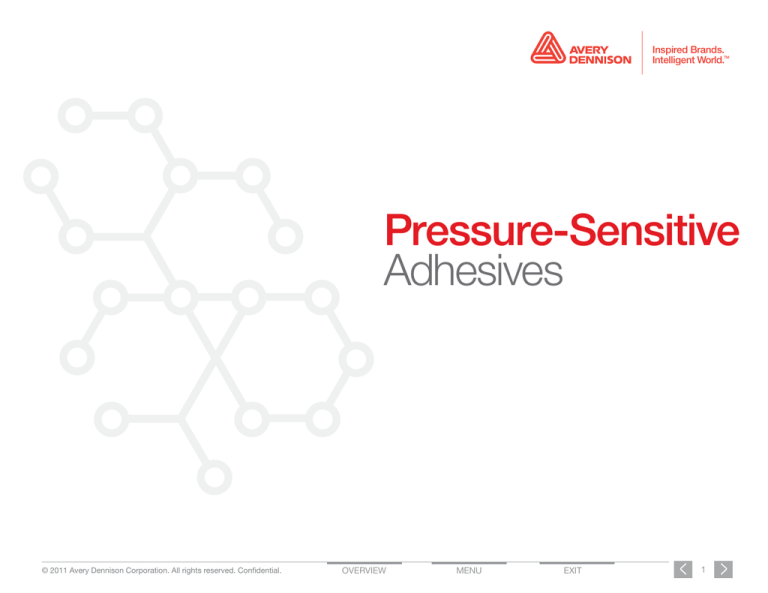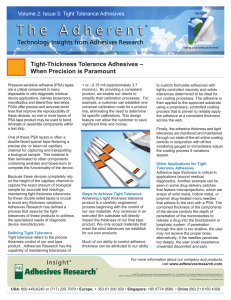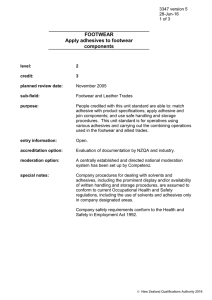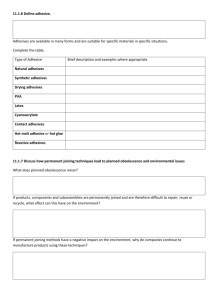
Inspired Brands.
Intelligent World.
TM
Pressure-Sensitive
Adhesives
© 2011 Avery Dennison Corporation. All rights reserved. Confidential.
OVERVIEW
MENU
EXIT
<
1
>
Pressure-sensitive
adhesives
01. Introduction
No matter where you look, you’ll find Avery
Dennison™ adhesives: self-adhesive postage
stamps, mailing labels, bandages, automotive
bonding, clear beer labels and battery labels.
Our adhesives are also used on disk drives, consumer goods
labels, for medical products, architecture and transportation.
They have a broad performance range: from ultra-removable
to ultra-high adhesion – our adhesive products are ideal for
demanding applications in the electronics, medical, industrial,
graphics, construction and consumer goods industries.
Packaging labels clear & opaque
films and substrates
Durable goods labeling
Examples of Pressure-sensitive adhesives used in
different forms in various applications:
— Labels
— Medical Dressing
— Graphic Films
— Tapes
— Other Specialty Applications
Automotive adhesives designed to work on a variety of substrates
and conditions
© 2011 Avery Dennison Corporation. All rights reserved. Confidential.
OVERVIEW
MENU
EXIT
<
2
>
Pressure-sensitive adhesives
Our competitive advantage
Wide range
of substrates
Extensive
portfolio of
adhesive
products
We are backward integrated into adhesives
which gives us the ability to lead market
changes in adhesives and turn customer input
into proprietary materials.
Key adhesive technologies include solvent,
emulsion, mini-emulsion and suspension
polymerization techniques.
Global
experience
Strong research
capabilities
Our value to the customer
Our advantage is in our global presence, experience,
and an in depth knowledge of pressure-sensitive
adhesives, that allow us to create adhesives which
provide a range of solutions for the customer.
Core competencies
— Technical service support – ability to apply
adhesive know-how to solve problems
— Developing PSAs (Solvent,
Emulsion, Hot melt)
Wide range
of adhesive
performance
Backwards
integrated
into adhesive
production
— High-speed coating
— Understanding the value of adhesive’s
benefits/features for final-use markets
— Market/application knowledge
— Application testing capability
— Demonstrated product performance and
knowledge of the industry
© 2011 Avery Dennison Corporation. All rights reserved. Confidential.
OVERVIEW
MENU
EXIT
<
3
>
Pressure-sensitive adhesives
Definition of terms
—
Emulsions are acrylic polymers in water.
Labels and Packaging Materials (LPM) has
manufacturing capabilities in the US and Europe
and a toll manufacturing network to provide Avery
Dennison emulsions around the world.
— Solutions are the legacy technology for the
—
industry. They are acrylic polymers in petroleumbased solvents – usually of low to moderate
solids content. End users prefer the performance
but not at the cost.
Hot melt PSAs are based on block copolymers ­—
usually hard soft hard block SBC’s. Oils, plasticizers
and tackifiers are needed to obtain performance
criteria. Most hot melts (HM) are dependent on C5/
C9 streams from petroleum distilleries.
— UV: Compositions of coatable viscosities without
solvent. Produces thick films, including foam-like
adhesives. Dual stage process which creates
performance advantages through second stage
curing, which enables very high molecular weight
fractions which can’t be cast from solvent.
—
100% solids: Materials also known as warm
melts. They are either made in solvent and stripped
(AC resin) or polymerized to near 100% and coated.
Designed to utilize hot-melt equipment (high coating
speeds) and give performance of a solvent (current
state similar/better than emulsion). Benefits – high
coating speed and solvent-like performance.
Adhesive classifications
Permanent - An adhesive designed to stick to
a substrate without edge lifting that can not be
removed without damaging either the label or
the substrate.
Removable - An adhesive designed to stick to a
substrate without edge lifting that can be removed
without damage to either the label or the substrate.
© 2011 Avery Dennison Corporation. All rights reserved. Confidential.
OVERVIEW
MENU
EXIT
<
4
>
Pressure-sensitive adhesives
There are five types of
pressure-sensitive adhesives:
EMULSIONS
SOLUTIONS
HOT-MELTS
Emulsions are acrylic polymer
adhesives that are suspended
in water.
Solutions, also called solvent
adhesives, are acrylic polymers
in a petroleum-based
solution or solvent.
Hot-melts are based on block
copolymers usually hard soft
hard block SBC’s. Oils,
plasticizers and tackifiers are
added to improve performance.
ULTRAVIOLETS
100% SOLIDS
These adhesives have the
characteristic of being a
light-cured acrylic adhesive
(thermoset).
A 100% solids refers to
the amount of non-solvent
content in an adhesive
by weight.
© 2011 Avery Dennison Corporation. All rights reserved. Confidential.
OVERVIEW
MENU
EXIT
<
5
>
Pressure-sensitive adhesives
Adhesive technology
Pressure-sensitive adhesives are divided into categories based on the chemical composition of
the adhesive: Rubber-based and acrylic adhesives. The chemical makeup of the product is a major
contributor to the performance of the product.
Categories of adhesives
Hot-Melt
Rubberbased
Perm*
Rem**
Solvent
Rubberbased
Perm
Rem
Emulsion
Rubberbased
Acrylic
Perm
Rem
Acrylic
Rem
Perm
Rem
* Perm = Permanent
** Rem = Removeable
© 2011 Avery Dennison Corporation. All rights reserved. Confidential.
OVERVIEW
MENU
EXIT
<
6
>
Pressure-sensitive adhesives
Where do we utilize pressure-sensitive adhesives?
Adhesive technologies are a key component of our product lines.
Our adhesive solutions meet a range of specific requirements, from repositionability,
anti-microbal properties or moisture resistance, to operating in extreme environments
of heat or cold. By creating solutions for a broad spectrum of product needs, we have
the capability to produce innovations in the industries below:
Medical
Solutions
Skin adhesives:
— Catheter
— Medical tapes
— Wearable sensors
— Wound dressings
— Hydrocolloids
Graphics and
Reflective
Solutions
Graphic adhesives:
— Vehicle wraps
— Architectural films
— Reflective products
(highway signage)
Designed and
Engineered
Solutions
Durable adhesives:
— Instructional labels
(bonds to fabric
plastic, vinyl or
metal surfaces)
— Adhesive tapes
(trims)
Performance
Tapes
Specialty tapes:
— Automotive
— Electronics
— Building and
Construction
— Specialty Industrial
— Personal Care
Labeling and
Packaging
Materials
Labeling adhesives:
— Packaging labels
— Opaque labels
— Adhesive films
— Industrial hard
goods labeling
— Water resistant
Office and
Consumer
Products
Office labels:
— Address Labels
— Easy Peel® Clear
Mailing Labels
— NoteTabsTM
— Software/media
labels
RFID
RFID labels:
— Inventory
— Security
— Tracking
© 2011 Avery Dennison Corporation. All rights reserved. Confidential.
OVERVIEW
MENU
EXIT
<
7
>
Pressure-sensitive adhesives
The typical adhesive properties include:
Initial Tack - The immediate holding power of the label upon
contact with the substrate. A label with high initial tack will
grab the substrate quickly. A label with low initial tack will
exhibit a low level of adhesion when first applied and may
remove cleanly.
ADHESION
Ultimate Adhesion - The ultimate or maximum holding
power that the label will achieve as the adhesive penetrates
into the substrate. The time required to obtain ultimate adhesion may depend on the stiffness (shear) of the adhesive, the
roughness of the substrate and the temperature of the environment. Dwell time can vary from 2 to 24 hours depending
on the conditions. Initial tack and ultimate adhesion are not
necessarily related.
Shear Resistance - A measure of the internal cohesive
strength of the adhesive. The shear of the adhesive is an
indication of how soft an adhesive is. A low-shear adhesive
(soft) has more of a tendency to flow (resulting in higher
initial tack), and has a higher chance that the adhesive will
split apart if put under stress. A high-shear adhesive (firm) is
less likely to split under stress because of its good internal
cohesive strength, and will be less likely to flow (possibly
lower initial tack).
© 2011 Avery Dennison Corporation. All rights reserved. Confidential.
OVERVIEW
TACK
MENU
SHEAR
EXIT
<
8
>
Pressure-sensitive adhesives
Adhesive Technology
Rubber-based adhesives are formulated from organic
rubbers and resins. Rubber-based adhesives are typically
less expensive, however, they are effected by oxidation
and ultraviolet light, and are designed for general
purpose applications. Rubber-based adhesives, in
general, exhibit higher initial tack (quick stick) because
of the softer formulation, however, they are more prone to
cause sticky edges through adhesive flow (edge ooze*).
Removable rubber-based adhesives tend to increase in
adhesion throughout the life of the label and could possibly
become permanent.
Acrylic-based adhesives are formulated from cross-linked
acrylic polymers, and are typically more expensive but
resistant to high heat and oxidation. Acrylic-base adhesives,
in general, exhibit lower initial tack and require a longer
set-up period to obtain their maximum adhesion, however,
they are less prone to develop sticky edges and maintain a
more consistent level of removability on removable labels.
Modified Acrylic is an acrylic adhesive combined
with tackifying resins to enhance bonding properties.
They offer higher initial tack and improved bonding to
low-energy surfaces, but there is some loss of UV and
solvent resistance.
Silicone adhesives are used for specialty applications
such as high oxygen/gas permeability, low pain upon
removal to sensitive skin.
Examples of rubber-based and acrylic-based adhesives
C13
Organic rubber
Cross-linked acrylic
polymer
* Edge ooze is term used to describe the flow of adhesive out of the edge of the laminate.
Edge ooze causes a sticky edge and can cause feeding problems and contamination in
some printing processes.
© 2011 Avery Dennison Corporation. All rights reserved. Confidential.
OVERVIEW
MENU
EXIT
<
9
>
Pressure-sensitive adhesives
Emulsion-based PSAs
Emulsion polymers are commonly used for packaging,
labeling, and tapes. Label and Packaging Materials
uses emulsion adhesives extensively.
The main type of emulsion Avery Dennison uses
is acrylic polymers. Acrylics function well in both
permanent and removable PSAs. For permanent
PSAs, acrylics offer high tack and peel strength. For
removable usage, acrylic PSAs have good mechanical stability and cohesive strength. Acrylics work
across a wide variety of substrates and surfaces.
Vehicle wraps
Other types of emulsions include PVA (polyvinyl
acetate) and EVA (ethylene vinyl acetate).
Performance Tapes
© 2011 Avery Dennison Corporation. All rights reserved. Confidential.
OVERVIEW
MENU
EXIT
<
10
>
Pressure-sensitive adhesives
Solvent-based PSAs
Solvent-based adhesives are acrylic polymers
in petroleum-based solvents.
Advantages of solvent-based adhesives are their
strength. They provide superior shear and peel
strength to water-based adhesives. Solventbased PSAs tend to have better film formation,
and have higher moisture resistance than waterbased adhesives.
Examples of custom applications for sealing,
gasketing, shielding and sound insulation.
© 2011 Avery Dennison Corporation. All rights reserved. Confidential.
Foam tapes and adhesives are used in automotive
or other industrial applications where strength,
heat, or moisture resistance is required. Closeup application of heated mirror.
OVERVIEW
MENU
EXIT
<
11
>
Pressure-sensitive adhesives
UV PSAs
100% solids
A key benefit is no carrier solvents are needed
which means no drying ovens.
A 100% solids refers to the amount of non-solvent
content in an adhesive by weight. Hot-melt PSAs are
one type of 100% solid. Low-viscosity polymers that
are coated and reacted with radiation to change
molecular density/weight are one type, or highviscosity materials that are heated to reduce viscosity
for coating purposes and then cooled for final use.
These adhesives have the characteristic of being a
light-cured acrylic adhesive (thermoset). UV PSAs
are non-flamable and solvent free. UV adhesives
offer advantages of lower VOCs and better
environmental compliance.
Hot-melt PSAs
Hot-melt PSAs come in several forms:
— Styrenic block copolymers (SBCs) are most widely used. These require tackifiers and oil modifiers to achieve the desired adhesive
performance.
100% solids adhesives can also fall into this category.
© 2011 Avery Dennison Corporation. All rights reserved. Confidential.
OVERVIEW
MENU
EXIT
<
12
>



